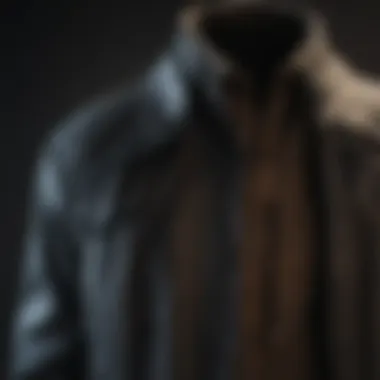Men's Jackets: The Perfect Blend of Style and Function


Intro
The world of men's jackets presents a rich tapestry of options that balance style and functionality. Each jacket is not just an article of clothing; it serves a unique purpose for the wearer, adapting to various conditions and occasions. In today’s diverse wardrobe landscape, understanding what each type of jacket offers can greatly enhance an individual's style and practicality. This exploration will break down different categories of jackets, delve into material nuances, and discuss important design elements. We will also touch on how to maintain these essential pieces and navigate emerging trends, making informed choices not just a possibility but a necessity.
The History of Jackets
Origin and Evolution
Jackets have a long-standing history that dates back centuries. Originally, they were practical garments designed for protection against the elements. Early jackets were made from leather and wool, offering durability and warmth. The functionality aspect was crucial, fully enveloping the body and safeguarding it from harsh weather.
Over time, jackets evolved in shape and material. From the fitted silhouettes of the 18th century to the looser fits of the 20th century, each era brought its own influences. Fashion began to imbue jackets with aesthetic appeal, transforming them from mere necessity to style statements.
Milestones and Influences
During the late 19th and early 20th centuries, the introduction of new materials such as nylon and polyester revolutionized jacket design. The functionality of jackets gained importance during wartime, leading to innovations such as the bomber jacket. This style not only offered protection but also became a symbol of rebellion in post-war eras, influencing youth culture significantly.
Additionally, sports culture and the rise of athleisure has had a deep impact on jacket styles today. The merging of utility and fashion is now seen in sporty designs that cater to both performance and everyday use.
Key Influencers and Trends
Certain figures have stood out in the jacket evolution. Designers like Ralph Lauren and brands such as Levi's have made significant contributions to how jackets are perceived and adopted by the public. As celebrities began sporting various jacket styles, they became associated with status and lifestyle. This influenced how men select jackets today, often reflecting both personal style and social identity.
"A jacket often serves as an introduction to one's personal style; it reflects status, taste, and utility."
Understanding Jacket Types
Navigating the vast array of jackets available can be daunting. Buyers should be aware of the common types and their specific uses. Here are some popular categories:
- Bomber Jackets
Classic and versatile; often made of leather or nylon, ideal for casual outings. - Puffer Jackets
Insulated and typically filled with down feathers, great for varying weather conditions. - Blazers
Tailored jackets suitable for formal occasions, combining polish with casual ease. - Denim Jackets
A staple for a laid-back look, offering durability and a nod to timeless fashion.
Culmination
Understanding the evolution and types of men's jackets helps in choosing the right piece that meets both style and functional requests. As trends evolve, the dynamic aspects of jacket design continue to captivate men's fashion. Choosing the right jacket takes thought and consideration, but it can significantly enhance an overall look while fulfilling practical needs.
Prolusion to Men's Jackets
In today's fashion landscape, men's jackets hold significant importance. They are not merely an accessory but essential garments that enhance both functionality and style. The right jacket can make a statement while serving practical purposes, such as protection from weather elements and adding layers to an outfit. By understanding the variety and purpose of jackets, men can optimize their wardrobes effectively.
The Evolution of Men's Outerwear
The history of men's outerwear reflects broader trends in society, culture, and technology. Initially, jackets served a purely functional purpose; they protected against harsh conditions. Over time, different styles emerged, influenced by military uniforms, workwear, and sports. Today, men's jackets come in a myriad of designs, materials, and functionalities. Options range from classic leather to modern synthetic blends. This evolution showcases how practicality can align with aesthetic aspirations. Understanding this evolution helps men appreciate the craftsmanship and intention behind each jacket choice.
The Role of Jackets in Men's Fashion
Jackets play a crucial role in shaping men's fashion. They can present a polished look for formal events or casual outings. Different styles cater to specific contexts—blazers for business meetings, denim jackets for leisure, and parkas for outdoor adventures. The versatility of jackets allows men to express individuality. Moreover, the right choice can elevate an outfit, transitioning it from mundane to sophisticated. When selecting a jacket, men should consider not only the look but also the functionality it offers. A well-chosen jacket can emphasize personal style while serving practical needs.
"Fashion is not just about clothing; it’s also about how these garments perform in real life."
Types of Jackets for Men
The selection of jackets for men reflects a fusion of style and practicality. Understanding the different types of jackets helps in making informed decisions for one's wardrobe. Each type serves distinct purposes, from casual outings to formal events. Therefore, grasping the essence of various jackets is crucial for both functionality and aesthetics.
Casual Jackets
Casual jackets become staple items that balance comfort with style.
Types of Casual Jackets
Casual jackets include denim jackets, bombers, and lightweight parkas. Each type offers versatile styling possibilities. The denim jacket, for instance, has a rugged charm and can be layered with different outfits. Bombers, with their fitted design, provide a sporty yet fashionable look. The lightweight parka is notable for its adaptability, making it suitable for varying temperatures.
A key characteristic of casual jackets is their ease of wear. They often require little thought to combine with jeans or chinos. This convenience makes casual jackets popular choices for everyday use. However, one must consider the material since some fabrics may not offer sufficient warmth in colder months.


Styling Casual Jackets
Casual jackets can be styled in numerous ways. Pairing them with a simple T-shirt and chinos enhances a laid-back look. Adding accessories, such as scarves or caps, can elevate the outfit. The layering opportunities are diverse, allowing for experimentation.
A significant feature is the color palette available. Casual jackets can come in vibrant shades or classic tones. This variety enhances their appeal, letting individuals express personal style. The downside may be the versatility; a casual jacket might seem too informal for specific settings unless styled intentionally.
Formal Jackets
Formal jackets play an important role in men’s wardrobes, particularly for professional and formal settings.
Different Styles of Formal Jackets
Common styles of formal jackets are blazers, sport coats, and tuxedos. Each has its unique traits. Blazers are versatile, working for both casual and formal events. Sport coats generally feature bolder patterns and textures, suitable for social gatherings. Tuxedos, however, are reserved for black-tie events.
The defining feature is their structured design, which enhances the male silhouette. This structure exudes confidence and professionalism. Formal jackets are essential for making strong impressions in business environments or formal gatherings. Their disadvantage can be limited wear, as they may not fit every social occasion.
Appropriate Occasions for Formal Jackets
Certain occasions demand formal jackets, such as weddings and corporate meetings. Blazers are often suitable for interviews or casual Fridays at work. In contrast, tuxedos are specifically for formal events like galas.
A notable advantage of formal jackets is their ability to elevate an outfit quickly. Simply donning a blazer can transform a simple shirt and trousers into a polished look. However, they may not provide the same comfort as casual jackets, making them less favorable for long durations.
Sport and Outdoor Jackets
Sport and outdoor jackets are designed to enhance functionality during physical activities.
Features of Sport Jackets
Sport jackets emphasize breathability and flexibility. Fabrics used are typically lighter and allow for movement, such as nylon and polyester. The incorporation of pockets serves practical needs, letting wearers carry essentials without bulk.
A highlight is their weather resistance. Many sport jackets feature waterproofing, aiding those who partake in outdoor adventures.
Usage Scenarios
The usage scenarios for sport jackets include hiking, camping, and active sports. They are engineered for performance. This attribute makes them popular choices for individuals engaging in outdoor activities. However, their sporty design may not lend itself well to formal occasions, limiting their versatility.
Layering Jackets
Layering jackets are pivotal for adapting to temperature changes.
Understanding Layering
Layering involves wearing multiple layers to manage warmth and comfort effectively. It is a strategic approach to dressing, allowing one to adjust based on weather conditions.
The primary benefit of layering jackets is adaptability. Users can mix and match layers for different scenarios. However, it may require initial planning to achieve desired looks without appearing bulky.
Choosing the Right Layer
Choosing the right layer can amplify the overall outfit. A lighter base layer, such as a T-shirt or thin sweater, works well with a thicker outer jacket. This combination ensures comfort across a range of temperatures.
The unique feature in layering is the ability to enhance or tone down an outfit. It allows for creativity in styling. Nevertheless, improper layering can lead to discomfort, hence knowing how to balance is key.
In summary, understanding the diverse types of jackets enables individuals to choose options that balance style with functionality, aligning with personal needs.
Materials Used in Jacket Construction
Understanding the materials used in jacket construction is crucial for anyone looking to enhance their wardrobe. The choice of fabric affects the jacket's durability, comfort, style, and suitability for various activities. By familiarizing oneself with different materials, individuals can make informed decisions that align with their personal needs and aesthetic preferences.
Common Fabrics and Their Benefits
Natural Materials


Natural materials such as cotton, wool, and leather are prominent in jacket construction. One key characteristic of these fabrics is their breathability. This feature contributes to overall comfort, especially in varying weather conditions. For instance, wool regulates temperature effectively, keeping the wearer warm in cold weather and cool when it's warm.
In addition, natural fibers tend to be softer against the skin, reducing irritation for users with sensitivities. However, it is important to note that some natural materials can be more susceptible to damage from moisture and may require special care.
The unique feature of leather is its durability and timeless appeal. When well-maintained, leather jackets can last for years, making them a popular choice. They offer a classic style that can be dressed up or down. Nevertheless, this type of material often comes with a higher price point and requires regular conditioning to maintain its quality.
Synthetic Materials
On the other hand, synthetic materials like polyester, nylon, and spandex also play a significant role in modern jacket design. A notable aspect of synthetic fabrics is their resilience. These materials are often engineered to be moisture-wicking and quick-drying, which is beneficial for those engaged in sports or outdoor activities. This characteristic ensures that jackets remain functional under a variety of conditions.
Another advantage of synthetic materials is their ease of care. Most synthetic jackets can be machine washed and dried, making them low-maintenance options for everyday wear. However, a unique feature of some synthetic fabrics is that they can cause discomfort due to poor breathability, especially when worn for extended periods.
While synthetic options may not have the same classic aesthetic as natural fibers, their performance under demanding conditions makes them a viable choice for adventure seekers who prioritize functionality.
Innovative Material Technologies
In recent years, the advancement of textile technology has led to the development of innovative materials that enhance jacket functionality. These technologies often aim to merge the best attributes of both natural and synthetic materials.
For example, some companies are creating jackets that incorporate moisture-wicking linings with breathable outer shells. Others are utilizing eco-friendly materials that offer performance benefits without the environmental impact associated with traditional fabrics. Additionally, smart textiles that feature embedded sensors for temperature regulation are gaining popularity in the market.
Such innovations not only cater to the need for practicality but also open new avenues in they way jackets are designed and used. They address the evolving needs and preferences of the modern-day wearer.
"By blending traditional materials with modern technology, we can create jackets that offer both style and unmatched performance."
Amid these advancements, it is essential for consumers to remain mindful of how material choices affect their experience and satisfaction with their jackets. This knowledge empowers individuals to select garments that are both practical and representative of their personal style.
Design Considerations
Design considerations are crucial in selecting the right men's jackets. They influence not just the aesthetics but also the utility of the garment. The way a jacket fits, its color and pattern, and the functional features it possesses all play a role in how well it serves its purpose. By assessing these aspects, a person can better align their choice with both personal style and practical needs.
Fit and Tailoring
Understanding Different Fits
Understanding different fits is essential for achieving the desired look and function of a jacket. A well-fitted jacket enhances the overall appearance and can make a significant difference in comfort. Typically, jackets are classified into several fits, including slim, regular, and relaxed.
- Slim Fit: This type is close to the body, offering a modern silhouette. It is beneficial for showcasing a stylish physique. The main characteristic of slim fit jackets is the tapered waist, which provides a neat look. However, it may limit comfort for those who prefer more room.
- Regular Fit: Regular fit jackets strike a balance between comfort and style. They provide enough space without looking baggy, making them suitable for various body types. This offers versatility and is popular because it can be worn casually or dressed up.
- Relaxed Fit: This type allows for maximum freedom of movement. It's especially great for outdoor activities or casual wear. However, the loose fabric can sometimes provide a less polished look, which may not be desirable in more formal settings.
Each type of fit has its own advantages and disadvantages, depending on the context in which the jacket will be worn.
The Importance of Tailoring
The importance of tailoring in jackets cannot be overstated. Tailoring customizes a jacket to fit an individual’s unique body shape. A well-tailored jacket not only looks attractive but also moves well with the wearer.
- Customization: Tailoring allows for adjustments in areas like sleeve length and waist tightness. This customization ensures a better fit and overall comfort.
- Professional Appearance: A tailored jacket presents a sleek look. It shows attention to detail and can enhance confidence, particularly in professional settings. The downside is the extra cost and time involved to get the right adjustments made.
- Value: A tailored jacket tends to last longer because the fit is specific to the person’s body structure. This could lead to higher satisfaction and less frequent replacements.
In this article, tailoring emerges as an essential component to elevate one’s wardrobe significantly.
Color and Pattern Selection
The choice of color and pattern is another vital aspect of jacket design. These elements influence not only personal expression but also how the garment fits within various settings. Neutral colors like navy, gray, and black are versatile and can complement multiple outfits. Brighter colors can add flair but may be more suitable for specific occasions. Patterns, such as checks or stripes, can make a bold fashion statement or provide a classic touch, depending on personal style preferences.
Functional Features
The functional features in jackets are critical for meeting the practical needs of wearers. Two significant aspects are pockets and fastenings as well as water-resistance and breathability.
Pockets and Fastenings
Pockets and fastenings serve both decorative and practical purposes in jacket design. They contribute to the overall functionality.
- Types of Pockets: There are various pocket styles like flap, welt, and zippered. Each serves different purposes, with zippers providing security for valuables, while flap pockets offer a classic look.
- Fastenings: The fastening systems, whether buttons, zippers, or snaps, are essential for ease of wear. A zipper might offer better protection from the wind, while buttons can enhance style. The disadvantage of some fastenings is their durability; zippers may malfunction after repeated use.


Water-Resistance and Breathability
Water-resistance and breathability are crucial for functional jackets, especially for outdoor activities. A jacket that resists water helps keep the wearer dry in wet conditions, while breathability ensures comfort during intense physical activity.
- Materials: Technologies like Gore-Tex or DWR (Durable Water Repellent) coatings improve the water-repellent qualities of fabrics. These features are particularly favorable for adventure seekers and outdoor enthusiasts.
- Trade-offs: While water-resistant jackets may keep moisture at bay, they can sometimes sacrifice breathability. Selecting the right combination of both properties ensures the jacket remains comfortable during varied activities.
Caring for Your Jackets
Taking care of your jackets is essential for maintaining their appearance, functionality, and longevity. Proper care ensures that you can rely on your jackets for various situations, whether it's for a casual outing, a formal event, or outdoor adventures. Understanding the nuances of cleaning, maintenance, storage, and repair contributes to your overall investment in quality outerwear.
Cleaning and Maintenance
Keeping your jackets clean not only looks good but also preserves the integrity of the fabric. Each type of jacket requires specific cleaning and care instructions to function effectively for its intended purpose.
Wash Care Instructions
Cleaning jackets appropriately is a vital aspect of maintaining their style and performance. Many jackets come with labels that include care symbols, indicating how to wash them safely. Generally, you have options like machine wash, hand wash, or dry cleaning.
The key characteristic here is understanding fabric types. For example, jackets made of cotton or denim often tolerate machine washing, while leather or technical materials may require more delicate handling. Choosing the right method helps retain the jacket's comfort and longevity, ensuring it continues to meet your functional needs.
A unique feature of wash care instructions is that they prevent wear and tear caused by improper cleaning techniques. Neglecting these instructions can lead to fading colors or compromise the jacket's waterproof quality. Thus, following care instructions is a beneficial choice for ensuring that your jacket continues to serve its purpose effectively over time.
Storage Tips
Proper storage plays a significant role in the longevity of your jackets. When not in use, it’s crucial to store them correctly to avoid distortion, wrinkling, or damage caused by environmental factors. Using garment bags for delicate fabrics or hanging jackets on wide hangers can help maintain their shape.
A notable characteristic of effective storage is that it keeps jackets free from dust and moisture, which can lead to the growth of mold or mildew. Additionally, adequate spacing should be provided between jackets to ensure they do not crease or become misshapen. This habit of proper storage aids in extending the life of your jackets.
While it’s easy to overlook storage practices, doing so has lasting advantages. Your jackets remain in top condition, ready for wear whenever needed, whether it be for everyday life or adventurous outings.
Repair and Alteration
When it comes to jackets, the need for repair and alteration is common. Damage can occur due to abrupt movements or even general wear. Understanding how to identify areas for repair is crucial, as this can mean the difference between creating functional outerwear and discarding it.
Small repairs, such as sewing loose buttons or fixing seams, can often be straightforward. Seeking professional help for more substantial alterations ensures your jacket fits perfectly and meets your style needs. While it might seem easier to purchase a new jacket, alterations can give a fresh life to an existing piece, making it a worthwhile investment.
Current Trends in Men's Jackets
In the rapidly changing landscape of fashion, staying informed about current trends in men's jackets is essential for both style and practicality. Understanding these trends can empower individuals to make more informed purchasing decisions, ensuring that their wardrobe reflects not only personal taste but also functionality appropriate for diverse situations. The focus on sustainability and technology shapes the contemporary jacket market, aligning with greater consumer awareness and shifting demands.
Sustainable Fashion Initiatives
Sustainability is no longer just a buzzword; it is now a guiding principle in the fashion industry, including men's jackets. Sustainable fashion initiatives aim to reduce waste, lower carbon footprints, and promote ethical manufacturing practices. Brands are increasingly opting for eco-friendly materials such as organic cotton, recycled polyester, and hemp. These fabrics are not only better for the environment but also durable and long-lasting, which can actually offer better value over time.
Here are some key points to consider regarding sustainable jackets:
- Material Selection: Look for jackets made from sustainable materials. Fabrics like Tencel and reclaimed wool are increasingly popular.
- Production Transparency: Brands that disclose their manufacturing processes tend to prioritize ethical practices. Knowing how your jacket was made can guide your buying decisions.
- Durability: Investing in a high-quality jacket reduces the need for frequent replacements, thus minimizing waste.
“Sustainability in fashion is not just a trend; it is a necessary evolution for the industry.”
Staying aligned with sustainability not only helps protect the environment but also enhances one's personal brand, appealing to others who value ethical considerations.
Tech-Infused Functionalities
The integration of technology into men's jackets is becoming increasingly prevalent. Tech-infused functionalities include features such as moisture-wicking fabrics, built-in insulation, and even smart textiles. These enhancements serve to elevate the performance of jackets, making them suitable for various activities and environments.
Some remarkable technological advancements to observe include:
- Climate Control: Jackets equipped with temperature control systems help maintain comfort by adjusting insulation based on body heat.
- Smart Fabrics: Some brands are introducing fabrics that can change color, texture, or warmth depending on external conditions.
- Integrated Wearable Tech: Certain jackets now come with pockets designed for tech gadgets or built-in charging capabilities for devices, blending convenience with style.
Closure
Summarizing the Importance of Choosing Wisely
When considering men’s jackets, a few essential elements emerge.
- Functionality: A jacket must meet specific functional needs, such as weather protection or fit for activities like hiking or commuting. For example, waterproof jackets are crucial for outdoor adventures, while more tailored pieces can enhance formal appearances.
- Material: Understanding the various materials available is necessary. Natural fabrics such as wool offer warmth and breathability, while synthetics can provide durability and water resistance. Each material affects style and performance.
- Fit and Design: Proper fit and thoughtful design are key in achieving both comfort and style. This is where tailoring comes into play. An ill-fitting jacket can detract from one's look, regardless of the quality of its construction or material.
- Care and Maintenance: An equally significant consideration is how one maintains the jacket. Proper care prolongs the life of the garment, ensuring that it remains a staple in the wardrobe for years. Cleaning instructions and storage tips are essential for preserving the integrity of the jacket.
By taking into account these factors, one is more likely to invest in a jacket that is versatile, functional, and truly reflective of personal style. In today's fast-paced world, where choices abound, making informed decisions is crucial to curating a wardrobe that meets individual needs while remaining stylish. Therefore, approaching jacket selection through thoughtful consideration leads to enhanced satisfaction and a more polished appearance.







